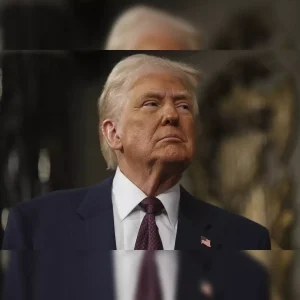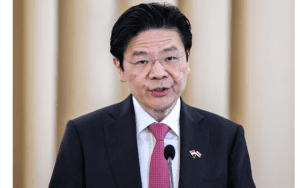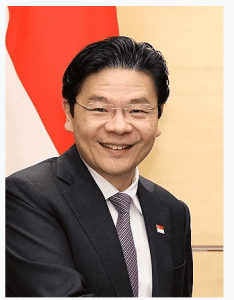Singapore: In a significant disruption to the global trade architecture, U.S. President Donald Trump, during his current term, has enacted a comprehensive and unilateral tariff regime, targeting imports from a wide array of global trading partners, including long-standing allies like Singapore. The tariffs, justified under the guise of achieving “reciprocal trade fairness,” mark a stark departure from the traditional U.S. commitment to open-market policies and multilateral trade cooperation.
Responding to these developments, Singaporean Prime Minister Lawrence Wong characterized the move as a “geostrategic inflection point,” warning that it fundamentally challenges the principles of the rules-based international economic order that have governed global trade since World War II. PM Wong emphasized that this shift reflects not just a policy change but a deep structural transformation in the global trading system. Trade analysts echo his concerns, describing the tariffs as emblematic of rising economic nationalism that threatens decades of liberal economic integration and risks triggering a new wave of supply chain fragmentation and retaliatory trade wars.
Check the Video here: PM Lawrence Wong on implications of US tariffs for Singapore | Full video
Also Read: Wall Street Futures Drop Up to 3% as China Imposes 34% Devastating Tariffs on US Goods
🔍 Nature and Scope of the U.S. Tariffs
 On April 2, 2025, the United States, under the direction of President Donald Trump, formally imposed a sweeping tariff policy framed as part of its “America First Trade Recalibration” initiative. Leveraging Section 301 of the U.S. Trade Act of 1974, the administration announced reciprocal tariffs ranging from 10% to 50% on imports from selected countries deemed to be running persistent and structural trade surpluses with the U.S. While this provision is traditionally used to respond to unfair trade practices, its application here marks a controversial expansion of scope.
On April 2, 2025, the United States, under the direction of President Donald Trump, formally imposed a sweeping tariff policy framed as part of its “America First Trade Recalibration” initiative. Leveraging Section 301 of the U.S. Trade Act of 1974, the administration announced reciprocal tariffs ranging from 10% to 50% on imports from selected countries deemed to be running persistent and structural trade surpluses with the U.S. While this provision is traditionally used to respond to unfair trade practices, its application here marks a controversial expansion of scope.
Notably, Singapore—a longstanding trade and strategic partner of the United States and a signatory to the U.S.-Singapore Free Trade Agreement (USSFTA)—was included in the 10% tariff bracket. This inclusion came despite Singapore currently running a bilateral trade deficit with the United States, where U.S. exports to Singapore exceed Singapore’s exports to the U.S. This has raised substantial legal, economic, and diplomatic concerns, particularly around the apparent non-discriminatory and arbitrary nature of the categorization.
Key elements of the U.S. tariff structure:
-
A flat 10% tariff on all goods of Singapore origin, without any product-specific investigations or safeguard mechanisms. This blanket approach contradicts the norms of targeted trade remedies typically used in WTO-sanctioned practices.
-
Suspension of tariff concessions under certain USSFTA chapters, particularly those related to industrial goods (Chapter 2), rules of origin (Chapter 5), and market access (Chapter 3), effectively nullifying negotiated benefits without formal treaty abrogation.
-
Immediate implementation with minimal transitional relief—exporters and logistics firms were given just 72 hours from the notice to adapt, causing significant disruption in scheduled shipments, customs documentation, and supply chain contracts.
Legal and multilateral implications:
Trade law experts have raised red flags over potential violations of WTO rules, particularly:
-
Most-Favored-Nation (MFN) Treatment (GATT Article I): Singapore is arguably being treated less favorably than other WTO members with similar economic profiles but no tariffs applied.
-
National Treatment & Proportionality (GATT Article III & XXIII): The tariff decision lacks a transparent due process framework and disregards economic reciprocity metrics.
Additionally, bypassing formal investigative processes or consultations through either the USSFTA Dispute Settlement Mechanism or WTO’s Dispute Settlement Body (DSB) raises concerns about the erosion of procedural legitimacy in global trade governance. The move may further destabilize trust in bilateral FTAs and multilateral institutions at a time when geopolitical fragmentation is already on the rise.
PM Wong: “More Dangerous Global Environment”
In a nationally televised address on April 4, 2025, Singapore’s Prime Minister Lawrence Wong characterized the recent U.S. tariff impositions as indicative of a “seismic change in the global order.” He expressed concern that these actions represent a shift from established multilateral trade practices toward bilateral coercion and economic nationalism, potentially undermining the rules-based international system that has underpinned global commerce for decades.


Prime Minister Wong emphasized the necessity for Singapore to reassess its strategic economic dependencies, particularly in light of the increasing use of trade measures as instruments of geopolitical leverage. He highlighted the importance of agility, resilience, and diversification in Singapore’s economic strategies to navigate this evolving landscape.
In his address, Prime Minister Lawrence Wong stated:
“What we are witnessing is not merely an increase in tariffs; it is a fundamental reconfiguration of the global trading system. Singapore must remain agile, deepen our resilience, and actively pursue diversification to safeguard our economic interests.”
These sentiments are consistent with Prime Minister Wong’s previous statements on the global economic environment. In a speech at the G20 Summit in Rio de Janeiro in November 2024, he underscored the importance of preserving the rules-based multilateral order amidst rising nationalism and protectionism. He asserted that platforms like the G20 are vital for fostering common ground among nations and that Singapore must remain engaged in such forums to effectively address global challenges.
📉 Macroeconomic Implications for Singapore
In response to the newly imposed U.S. tariffs, the Ministry of Trade and Industry (MTI), under the leadership of Minister Gan Kim Yong, has undertaken a comprehensive reassessment of Singapore’s economic projections for 2025. The revised forecasts indicate potential downturns across several key economic indicators:
| Indicator | Pre-Tariff Forecast | Revised Outlook (Post-Tariff) |
|---|---|---|
| GDP Growth | 2.5% – 3.0% | 1.8% – 2.2% |
| Non-Oil Domestic Exports (NODX) | +4.0% | -1.5% to 0.5% |
| Inflation | 3.1% | 3.6% – 4.2% |
Minister Gan highlighted that the tariffs are likely to disrupt supply chain throughput, particularly affecting high-value sectors where Singapore serves as a regional hub. These sectors include semiconductors, biotechnology, and aerospace components. The annual export exposure to U.S. demand in these areas is substantial, with direct value chain dependencies in electronics and chemical intermediates.
The MTI’s analysis suggests that the tariffs could lead to a realignment of trade flows and necessitate strategic adjustments by Singaporean firms to mitigate adverse impacts. This includes exploring alternative markets, enhancing competitiveness through innovation, and strengthening regional partnerships to diversify economic dependencies.
In light of these developments, the Singaporean government remains committed to upholding the principles of free trade and multilateralism, while proactively adapting to the shifting dynamics of the global economic landscape.
Diplomatic and Legal Strategy: Retaliation Avoided
In a display of measured strategic restraint, Singapore has chosen not to retaliate immediately against the newly imposed U.S. tariffs—despite possessing WTO-compliant legal grounds to do so. According to Minister for Trade and Industry Gan Kim Yong, any form of reciprocal tariff action would likely intensify cost-push inflation and undermine Singapore’s port-centric re-export model, which relies on seamless global trade flows and just-in-time logistics.
“Retaliation, while legally defensible, would harm our own economic structure more than it would affect the U.S.,” said Gan in a press conference following the MTI’s tariff impact assessment.
Instead, Singapore is activating diplomatic channels and institutional mechanisms within the U.S.-Singapore Free Trade Agreement (USSFTA) to pursue redress. Specifically, Singapore has filed a formal request to convene the Dispute Settlement Mechanism (DSM) panel under the USSFTA, aiming to negotiate for:
-
Product-level exclusions, especially for strategic sectors such as semiconductors, pharmaceuticals, and precision engineering.
-
A targeted waiver mechanism for high-tech and dual-use goods, critical to both civilian and defense-industrial supply chains.
Meanwhile, the Attorney-General’s Chambers (AGC), in collaboration with international trade law experts, is evaluating the viability of initiating proceedings at the World Trade Organization’s Dispute Settlement Body (DSB). However, Singapore remains cautious, recognizing the paralysis of the WTO Appellate Body, which has been rendered ineffective due to a U.S.-led block on judicial appointments since 2019. As a result, any WTO judgment risks becoming non-binding if appeals are stalled.
“It is not just about legal remedies, but whether those remedies can be enforced in today’s fractured multilateral trade regime,” said a senior trade diplomat familiar with Singapore’s WTO strategy.
🌐 Foreign Policy Dimensions: A Fractured Multilateralism
The geopolitical undertone of the U.S. tariff action has prompted a forceful diplomatic response from Singapore’s foreign policy leadership. Minister for Foreign Affairs Dr. Vivian Balakrishnan condemned the move as a “clear erosion of trust in global norms and interdependence.” Speaking at a press briefing held at the MFA headquarters, he stressed that such economic measures undermine interconnectedness, which for decades acted as a strategic stabilizer in global politics.
“We are seeing global rules replaced by power dynamics,” said Dr. Balakrishnan. “Trade interdependence was once a bulwark against conflict. Now it’s being turned into a tool of strategic pressure.”
Echoing this sentiment, Minister for Law and Home Affairs K. Shanmugam framed the tariffs as a manifestation of the growing fusion of geopolitics and economics—a trend he characterized as dangerous for small, open economies like Singapore. He underscored the need to fortify regional economic architecture, calling for accelerated integration through:
-
The Regional Comprehensive Economic Partnership (RCEP), which provides access to a broad Asia-Pacific market while reducing dependency on trans-Pacific arrangements.
-
The ASEAN Economic Community (AEC), which offers intra-regional supply chain resilience and shared policy frameworks for managing external shocks.
“We are in a new era where economics is increasingly being subsumed into strategic calculus. Our response must be to strengthen our regional partnerships and reduce systemic exposure to any single power,” said Shanmugam.
Singapore’s foreign policy now pivots around hedging against global fragmentation, while simultaneously preserving its open-market identity through diversified bilateral and plurilateral trade alliances, digital economy agreements, and innovation partnerships.
Global Spillover Effects and U.S. Domestic Repercussions
The implications of the U.S. tariff escalation are not confined to targeted countries like Singapore; global economic analysts warn of widespread macroeconomic fallout and domestic blowback within the United States itself.
🔺 Inflationary Pressures on U.S. Households
According to an assessment by the Peterson Institute for International Economics (PIIE) and corroborated by Moody’s Analytics, the U.S. Consumer Price Index (CPI) is projected to rise by approximately 2.3% over the next fiscal year due to the direct and pass-through effects of broad-based tariffs. This could impose an average additional burden of US$3,800 per household annually, driven by higher costs of imported intermediate and consumer goods.
📉 Decline in GDP and Trade Efficiency
Macroeconomic models by the Congressional Budget Office (CBO) suggest a potential 0.9 percentage point decline in U.S. GDP growth, as retaliatory measures from affected countries reduce U.S. export volumes, and domestic producers struggle with low elasticity in import substitution, particularly in capital goods and electronics.
The average effective tariff rate in the United States has now surged to 22.5%, the highest since the Payne-Aldrich Tariff Act of 1909—a protectionist measure that had once been blamed for exacerbating the Great Depression. This level of trade restrictiveness signals a sharp break from the post-war liberal trade consensus and is expected to reverberate through both global supply chains and investor sentiment.
🌏 Geopolitical Realignment in Asia
The move has also sparked concerns over geostrategic trade realignment, especially in Southeast Asia. Analysts at the ASEAN+3 Macroeconomic Research Office (AMRO) note that countries within ASEAN may pivot more decisively toward China, utilizing the Regional Comprehensive Economic Partnership (RCEP) and Belt and Road Initiative (BRI) as conduits for trade facilitation and investment flows.
“What we’re seeing is not decoupling, but ‘re-coupling’—with different hubs of economic influence emerging,” noted Dr. Jayant Menon, a visiting fellow at ISEAS–Yusof Ishak Institute.
🚧 Strategic Outlook: Economic Resilience & Trade Diversification
As geopolitical trade tensions mount and economic nationalism gains traction globally, Singapore is fast-tracking a calibrated strategy of trade diversification and industrial resilience. The goal is clear: shield the economy from external shocks while preserving its global competitiveness and relevance as a high-tech, high-value trading and investment hub.
🔄 Bilateral and Regional Economic Architecture
Singapore’s forward-looking trade policy is being recast through a mix of bilateral agreements, plurilateral frameworks, and digital trade partnerships, all aligned with its Smart Nation and Future Economy agendas.
Key pillars of this architecture include:
-
Bilateral Free Trade Agreements (FTAs) with non-traditional partners such as:
-
United Arab Emirates (UAE): Focusing on green energy, fintech, logistics, and AI-based industrial solutions.
-
Brazil and Egypt: Leveraging their resource-based economies for expanded trade in agri-tech, biopharmaceutical ingredients, and renewable technology.
-
-
Regional Integration Initiatives:
-
CPTPP (Comprehensive and Progressive Agreement for Trans-Pacific Partnership): Singapore is championing expansion and digital annexes to ensure interoperability of supply chains, customs digitization, and trade facilitation.
-
Digital Economy Agreements (DEAs): Signed with South Korea, Chile, New Zealand, and Australia, DEAs allow seamless cross-border data flows, digital identity authentication, AI governance standards, and electronic payments—all critical to sustaining Singapore’s position as a digital trade node.
-
This hybrid strategy ensures that Singapore is not overly reliant on Western-centric trade routes while deepening ties with emerging and digital-first economies.
🏭 Supply Chain Reconfiguration and Dual Sourcing
Amid global supply chain rebalancing, Singapore is reimagining its industrial base through Industry Transformation Maps (ITMs) and smart manufacturing incentives led by the Economic Development Board (EDB) and Enterprise Singapore.
Key developments include:
-
Nearshoring & Regionalization:
EDB is creating advanced manufacturing parks, including Wafer Fab Parks and BioMedTech Clusters, that promote nearshoring of critical nodes in high-risk industries such as:-
Semiconductors – front-end fabrication and backend assembly
-
Biologics and mRNA therapies
-
Green energy components – hydrogen electrolyzers, battery storage, carbon capture systems
-
-
Dual Sourcing and Risk Hedging Models:
Singapore is guiding MNCs to build redundant supplier networks and integrate blockchain-based traceability across their production systems. Firms are being incentivized via:-
Tax rebates and IP incentives under the Pioneer Certificate Incentive
-
Co-investments via EDBI (EDB Investments) for tech startups building B2B supply chain resilience tools
-
“Our goal is not just to survive global volatility but to reposition Singapore as a secure, agile, and future-ready node in the global supply chain,” said Beh Swan Gin, Chairman of EDB.
🧭 Strategic Autonomy without Isolation
While many economies face a binary choice between protectionism and dependence, Singapore has chosen a third path—strategic autonomy.
This approach is defined by:
-
Maintaining multilateral commitments, especially via WTO, APEC, and ASEAN Economic Community (AEC), while carving flexible bilateral carve-outs where needed.
-
Enhancing economic sovereignty by localizing key capabilities in pharmaceuticals, cloud computing, and food resilience through its 30 by 30 goal (producing 30% of nutritional needs locally by 2030).
-
Digital and Regulatory Resilience – Initiatives such as the SGTraDex platform and AI Verify create regulatory sandboxes for logistics and emerging tech, reducing dependence on any single country’s digital governance model.
In the words of PM Lawrence Wong, “Our diversification is not about disengagement, but empowerment—Singapore must be able to choose how, with whom, and on what terms it engages the global economy.”
📌 Conclusion: Navigating Uncertainty with Strategic Precision
Singapore now stands at a critical juncture amid one of the most consequential recalibrations of global trade in decades. The newly imposed U.S. tariffs are not merely a trade policy shift — they represent a deeper transformation in the architecture of global economic governance, marked by rising protectionism, transactional diplomacy, and erosion of multilateral norms.
⚖️ Strategic Non-Alignment as an Asset
Singapore’s long-standing non-aligned foreign policy, coupled with its institutional strength, regulatory predictability, and techno-legal diplomacy, continues to act as a stabilizing force. Its role as a trusted global trading hub is underpinned by a reputation for neutrality, efficiency, and rule-of-law governance — all of which are increasingly valuable in a fragmented international system.
“Our relevance has always been derived from being a reliable node in a globalized world. That will not change,” said PM Lawrence Wong in his closing remarks to Parliament on April 5, 2025.
🛡️ From Retaliation to Resilience
Unlike other economies that may resort to retaliatory tariffs or trade sanctions, Singapore’s approach underscores strategic restraint and proactive recalibration. This includes:
-
Leveraging international legal mechanisms under both the USSFTA and WTO frameworks.
-
Repositioning industrial policy to future-proof its key sectors.
-
Diversifying export markets and digital trade corridors through new-generation trade agreements and economic cooperation frameworks.
Such restraint is not a sign of weakness, but a demonstration of mature statecraft in an era where economic nationalism increasingly blurs the line between diplomacy and commerce.
🌐 A Voice for Open Markets


“We will shape the future of globalization — not wait to be shaped by it,” concluded PM Wong.
Singapore’s leadership remains committed to safeguarding its economic sovereignty through strategic foresight, legal diplomacy, and regional cooperation—while closely monitoring global developments that continue to reshape the architecture of international trade. For a deeper analysis of Singapore’s official stance, visit the Ministry of Trade and Industry’s official statement.

